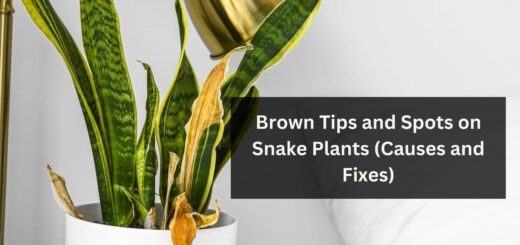Overwatered Spider Plant -Signs and Step-by-Step Solution
In this article, the readers will be acknowledged for how to know about the Overwatered Spider Plant, its Signs, and Step-by-Step solutions. If the soil drainage is poor then even the loved indoor hardy snake plants can get overwatered. The snake plants get overwatered when the pot size is not right.
Quick takeaways:
- The spider plants show stunted growth, yellow leaves, dullness, and dark spots on the leaves.
- The spider plants must be treated as soon as possible.
In this article, we will tell you the ways you can save overwatered snake plants. To get into the treatment you should know whether the snake plants are overwatered or not. So we will let you know about all the signs and symptoms that the overwatered spider plants indicate.
Underwatered vs. Overwatered spider plant
The overwatered and underwatered spider plants show similar signs so you must know what problem your spider plants are facing and treat them likewise.
1. Look at the soil first
Soil that seems dry and crispy means the spider plant is underwatered. The soil’s color also lightens if the soil is underwater whereas the soggy, wet squishy soil indicates that the spider plant is overwatered and the soil is not draining water well.
2. Leaves falling
The overwatered spider plants usually shed the leaves irrespective of the old and the new leaves. The leaves will fall no matter what. The underwatered spider plants are usable to form new growths.
3. Discoloration
The underwatered spider plants usually show discoloration in the leaves and the stems. The yellow color of the leaves indicates that the spider plant is underwatered.
The overwatered spider plants will show weak stems that are mushy where the water is surrounding them.
4. Look at the leaves
The leaves of overwatered spider plants show brown and yellow leaf tips whereas the brown tips are seen in underwatered spider plants.
Not just the leaves show wilting and curling but if the leaves look dry then they are underwatered and if the leaves look soggy and dull then they are overwatered and you need to stop watering the plant.
Signs and symptoms of overwatered spider plants
Whenever the plant is facing problems that means there might be some signs that you can look upon to consider that particular problem. Similarly, spider plants indicate being overwatered by these signs:
1. The appearance of yellow leaves
The leading sign of overwatered spider plants are the leaves losing the green color and the appearance of yellow leaves elevates.
The leaves at the plants’ base turn yellow and later the upper eaves are seen affected. The yellowing of leaves ultimately leads to shedding of the leaves which indicates the plants are dying and weakening severely.
2. Mushy and wet soil
Overwatering mainly leads to the soil staying wet for a long and ultimately causing the mold to grow on a large scale. The soil starts to turn mushy due to standing in water for a long.
The soil gets soggy due to poor drainage as well. If not drained or pass easily through the soil particles, water is poor drainage. The fungal growth will also infect the roots and root rot will also be seen.
3. Spotting on the leaves
Another sign that overwatered spider plants show is spotting on the leaves, brown spots can also be an indication that the plants are under stress and not getting enough nutrients, which can be due to the roots not being able to absorb the minerals and being surrounded by so much water and low aeration.
4. Wilting or curling of leaves
The curling of leaves is certain to happen due to overwatering as the water has damaged the roots that can absorb water, other reasons can be root rot that might have occurred due to standing water in the soil or soggy soil.
The droopiness in the leaves happens due to the plant getting limp and mushy. The leaves then start to fall on the ground. The curling of leaves is a defense mechanism for leaves to save the extra water loss as the plant is not getting enough water due to root rot.
“Learn character from trees, values from roots and change from leaves”
– By Tasneern Harneed
5. Browning of leaf edges and margins
The leaf tips and the leaf margins are usually brown when the spider plants are overwatered. The fading of leaves is an indication that you should stop watering the spider plants for a week or two.
6. Pest infestation
The overwatered spider plants are weak and are more prone to getting attacked by pests. The plants become less hardy and soft that pests can easily attack.
Pest infestation is another sign that the plant might be getting overwatered and you need to look at the plant closely and the soil too. Aphids, mealy bugs, whiteflies, etc. are seen to attack the limp snake plants.
7. Plant looks lean and dull
The spider plant’s turkey is becoming weak, lean, and dull in appearance. The plant is touching the ground which means the spider plant is dying.
If the plants are too dry and dull that means that roots are damaged and root rot has taken place.
How to save overwatered spider plants?
The root rot in the spider plants is alarming and needs to be treated as soon as possible as the spider plants are near to dying. Let’s see how to revive the overwatered spider plants
1. Uproots the spider plants
Remove the spider plant from the ground or pot. Gently take out the plant using a knife and scrape the edges so that the plant can be removed easily.
2. Wash the roots and remove the dirt
The roots need to be washed properly by brushing the roots, removing the extra dirt, or washing them with hydrogen peroxide. The extra soil needs to be removed so that the roots are visible.
3. Examine the rotted root
Take a look at the roots to see if there is any root rot, if not then repot the plant in the clean, good-draining pot. If there is rot, follow the below steps.
4. Remove the affected roots
Use sterilizer sharp pruning shears or scissors to cut the rotted roots and dispose of them away.
Give the plant a good amount of sunlight, let it dry, and then prepare to Repot it.
5. Use good potting mix
Use soil that has sand also so that the soil can drain water properly.
The potting mix should also have nutrients so that the plant can get minerals to revive back.
6. Repot the plant
Repot the plant in a pot with a good number of drainage holes. The pot should be clean and sterilized. Make sure to water the plant properly. Let the top inch of the soil get dry and then water the plant.
The overwatered plants such as pothos in other conditions can be saved by providing them heat for a day so that the excess moisture gets evaporated. You can use neem oil and soap solution for the pests on the snake plants. Use a fungicide to get rid of the fungus.
Footnote of the context
We hope you like our effort to give you every tiny detail regarding the overwatered spider plants and how you can get back your spider plants and make the indoor elegance come back again. We understand how loved spider plants are and it’s good that you check the soil and plant daily so that they don’t get into any kind of trouble, and keep thriving well. Happy planting!


